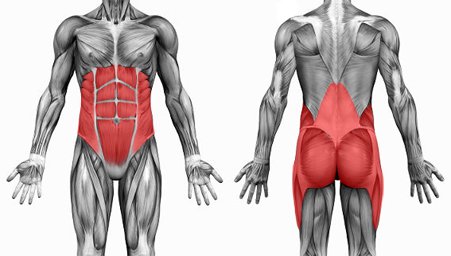Following up from last week’s blog on the truth about core training, today is all about strengthening your core to prevent lower back pain. Your core should be engaged when performing movements where you are required to lift, move and press objects, although what about when there is no weight involved – say in everyday movements like sitting, and walking.
Going through life you’ve probably had people tell you to ‘sit up straight in your chair’ or ‘stand up straight’ now when you go to do this and over emphasise your posture, what do you do? Stiffen your stomach and push your shoulders back? I thought so. While it’s all well and good to focus on correct posture and it is very important don’t get me wrong, there is something that we consciously do when standing and sitting up straight that isn’t 100% necessary.
If you consider the anatomy of your spine there is really no ‘core’ but instead a heap of muscles that work together to naturally provide movement and body posture (whether it be good or bad). For me to sit here and tell you that your ‘core’ is the area that supports and moves the spine on its own would be like saying that all the other muscles throughout the mid and lower back are useless. In reality, these muscles we forget about are very much moving and doing their job. Your spine, in conjunction with your lower back is a very clever thing, as when you’re walking, sitting or lying down the muscles are already working as they should be stiffening your back to some extent. *Now enter an individual religiously contracting their core while sitting or standing in an attempt to promote this ‘perfect posture’ * squeezing these abdominal muscles so hard putting a heap of unneeded pressure on the already stiffened spine. See where I’m going with this?
Over time we have been led to believe that stiffening your back is better and will protect it from injury, when in reality this pressure is causing compression, and compression can lead to pain. You shouldn’t have to sit in a chair and think about posture and ‘sitting up straight’ causing you to consciously stiffen your spine – this is doing you more harm than good. Chronic lower back pain has been shown to be associated more with psychological (fear and anxiety) and psycho social factors (individual beliefs that certain pain and activities are harmful) rather than anything to do with a ‘weak midsection’.
“Pre tensing your body before you move is not a normal act, our body works in a wonderful way as to do this all for itself”.
When it comes to you and your body all you need is a little trust. Your body will move and adapt to its normal healthy movement pattern. The muscles passing through your back are specifically designed to (and will) do their job in providing movement and you shouldn’t have to be consciously aware of it. We don’t pre-tense any other body part before sitting down or going for a run, so why are our backs any different?
By focusing so much on all these stomach contractions it’s actually hindering our ability for our body to move. When you think about it, you don’t kick a football by focusing on the sequence of muscle contractions through your legs, it’s done with spatial awareness.
Wrapping up, here’s the lowdown on the massive word vomit you just read.
- Weak trunk muscles, weak abdominals and imbalances are not correlated to lower back pain, just completely normal variations from person to person
- Weak abdominal muscles will not lead to back pain
- Consciously tensing the trunk muscles before movements is unlikely to provide protection against back pain and can actually sometimes be the cause of back pain.
- There may be potential danger of damaging the spine with continuous tensing of the trunk muscles throughout daily activities
So, if it’s just the six-pack you want then each to their own. Although if you’re slaving away at the gym trying to ‘strengthen your core’ as you see this is the way to a solid and well working lower back then you should change it up a little. Keep it simple, you shouldn’t be putting this extra strain through your already fully functional and mobile back muscles in order to ‘fix’ what doesn’t particularly need fixing.
References:
YouTube. (2017). Prof Peter O’Sullivan and Core Stability – April 2012. [online] Available at: https://www.youtube.com/watch?v=YezBG_NdLgs
Kamal, Y. (2015). Lower Back Pain; Evolution of Back School Therapy. Journal of Spine, 04(04).
Szerla, M., Ortenburger, D., Kluszczyński, M. and Wyszomierska, J. (2017). Exercise and psychological factors in low back pain. Physical Activity Review, 5, pp.6-9.
Why is core spine integrity related to low back pain?. (2015). Itch & Pain.
Gray Cook Movement. (2017). Gray Cook Movement. [online] Available at: http://graycookmovement.com/
Zangoni, G. and Thomson, O. (2017). ‘I need to do another course’ – Italian physiotherapists’ knowledge and beliefs when assessing psychosocial factors in patients presenting with chronic low back pain. Musculoskeletal Science and Practice, 27, pp.71-77.
